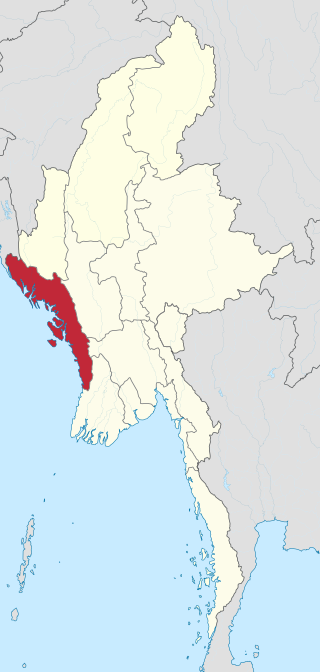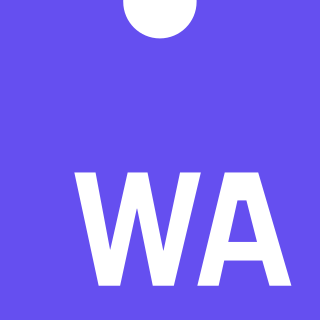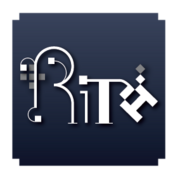
JavaScript, often abbreviated as JS, is a programming language and core technology of the World Wide Web, alongside HTML and CSS. As of 2023, 98.7% of websites use JavaScript on the client side for webpage behavior, often incorporating third-party libraries. All major web browsers have a dedicated JavaScript engine to execute the code on users' devices.
In phonology and linguistics, a phoneme is a set of phones that can distinguish one word from another in a particular language.

In linguistics, specifically phonetics and phonology, schwa is a vowel sound denoted by the IPA symbol ⟨ə⟩, placed in the central position of the vowel chart. In English and some other languages, it usually represents the mid central vowel sound, produced when the lips, tongue, and jaw are completely relaxed, such as the vowel sound of the ⟨a⟩ in the English word about.

Javanese is a Malayo-Polynesian language spoken by the Javanese people from the central and eastern parts of the island of Java, Indonesia. There are also pockets of Javanese speakers on the northern coast of western Java. It is the native language of more than 98 million people.
Old Javanese or Kawi is the oldest attested phase of the Javanese language. It was spoken in the eastern part of what is now Central Java and the whole of East Java, Indonesia. As a literary language, Kawi was used across Java and on the islands of Madura, Bali and Lombok. It had a sizable vocabulary of Sanskrit loanwords but had not yet developed the formal krama language register, to be used with one's social superiors that is characteristic of modern Javanese.

Jawi is a writing system used for writing several languages of Southeast Asia, such as Acehnese, Banjarese, Kerinci, Maguindanaon, Malay, Mëranaw, Minangkabau, Tausūg, and Ternate. Jawi is based on the Arabic script, consisting of all of the original 31 Arabic letters, and six additional letters constructed to fit the phonemes native to Malay, and an additional phoneme used in foreign loanwords, but not found in Classical Arabic, which are ca, nga, pa, ga, va, and nya.

Processing is a free graphical library and integrated development environment (IDE) built for the electronic arts, new media art, and visual design communities with the purpose of teaching non-programmers the fundamentals of computer programming in a visual context.
Codework is "a type of creative writing which in some way references or incorporates formal computer languages within the text. The text itself is not necessarily code that will compile or run, though some have added that requirement as a form of constraint." The concept of and term 'codework' was originally developed by Alan Sondheim, but is also practiced by and used to refer to the work of other Internet artists such as Mez Breeze, Talan Memmott, Ted Warnell, Brian Lennon, and John Cayley. Scholar Rita Raley uses the term "[net.writing]," which she defines as "the use of the contemporary idiolect of the computer and computing processes in digital media experimental writing." Raley sees codework as part of a broader practice exploring "the art of code."

Etherpad is an open-source, web-based collaborative real-time editor, allowing authors to simultaneously edit a text document, and see all of the participants' edits in real-time, with the ability to display each author's text in their own color. There is also a chat box in the sidebar to allow meta communication.
CoffeeScript is a programming language that compiles to JavaScript. It adds syntactic sugar inspired by Ruby, Python, and Haskell in an effort to enhance JavaScript's brevity and readability. Specific additional features include list comprehension and destructuring assignment.
In contemporary Japanese writing, foreign-language loanwords and foreign names are normally written in the katakana script, which is one component of the Japanese writing system. As far as possible, sounds in the source language are matched to the nearest sounds in the Japanese language, and the result is transcribed using standard katakana characters, each of which represents one syllable. For example, America is written アメリカ (A-me-ri-ka). To accommodate various foreign-language sounds not present in Japanese, a system of extended katakana has also developed to augment standard katakana.

Three.js is a cross-browser JavaScript library and application programming interface (API) used to create and display animated 3D computer graphics in a web browser using WebGL. The source code is hosted in a repository on GitHub.
Underscore.js is a JavaScript library which provides utility functions for common programming tasks. It is comparable to features provided by Prototype.js and the Ruby language, but opts for a functional programming design instead of extending object prototypes. The documentation refers to Underscore.js as "the tie to go along with jQuery's tux, and Backbone.js' suspenders." Underscore.js was created by Jeremy Ashkenas, who is also known for Backbone.js and CoffeeScript.

Rakhine, also known as Arakanese, is a Sino-Tibetan language spoken in western Myanmar, primarily in the Rakhine State. Closely related to Burmese, the language is spoken by the Rakhine and Marma peoples; it is estimated to have around one million native speakers and it is spoken as a second language by a further million.

María Mencía is a Spanish-born media artist and researcher working as a Senior Lecturer at Kingston University in London, United Kingdom. Her artistic work is widely recognized in the field of electronic literature, and her scholarship on digital textuality has been widely published. She holds a Ph.D. in Digital Poetics and Digital Art at the Chelsea College of Arts of the University of the Arts London and studied English Philology at the Complutense University of Madrid.
JSON Web Token is a proposed Internet standard for creating data with optional signature and/or optional encryption whose payload holds JSON that asserts some number of claims. The tokens are signed either using a private secret or a public/private key.

WebAssembly defines a portable binary-code format and a corresponding text format for executable programs as well as software interfaces for facilitating interactions between such programs and their host environment.
John Howland Cayley is a Canadian pioneer of writing in digital media as well as a theorist of the practice, a poet, and a Professor of Literary Arts at Brown University.
ReRites is a literary work of "Human + A.I. poetry" by David Jhave Johnston that used neural network models trained to generate poetry which the author then edited. ReRites won the Robert Coover Award for a Work of Electronic Literature in 2022.
Notes on the Voyage of Owl & Girl is a generative HTML work written by J.R. Carpenter. It debuted in 2013 and was printed in 2014. The work has little to no user input to control this story. The work includes some Morse code that can be translated into a message.









